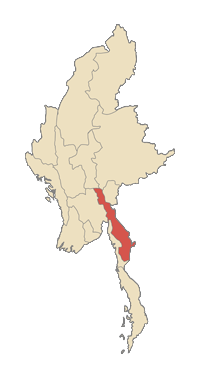Karen people
Most scholars dismiss the notion of a Gobi desert crossing, but rather translate the legend as describing "rivers of water flowing with sand".
It is estimated by linguists Luce and Lehman that the Tibeto-Burman peoples such as the Karen migrated into present-day Myanmar between 300 and 800 CE.
[10] Karen refers to a heterogeneous lot of ethnic groups that do not share a common language, culture, religion, or material characteristics.
[11] A pan-Karen ethnic identity is a relatively modern creation, established in the 19th century with the conversion of some Karen to Christianity and shaped by British colonial policies and practices.
[11] The word may have originally been a derogatory term referring to non-Buddhist ethnic groups, or it may derive from Kanyan, a possibly Mon name of a vanished civilisation.
[14] Estimates suggest that the Karen began inhabiting what is now Myanmar approximately 2,500 years ago, migrating from regions that are now Mongolia and Tibet.
A study focusing on the Kayah (Red Karen) in Northern Thailand analyzed autosomal short tandem repeats (STRs) and Y-chromosomal haplogroups.
The findings revealed that the Kayah people are genetically closer to other Southeast Asian populations than to those from Northeast Asia or Tibet.
[22] Some Karen have left the refugee camps in Thailand to resettle elsewhere, including in North America, Australia, New Zealand, and Scandinavia.
[24] Christian Karens were favoured by the British colonial authorities and were given opportunities not available to the Burmese ethnic majority, including military recruitment and seats in the legislature.
Three years later, after submitting a criticism of the 1920 Craddock Reforms, they won 5 (and later 12) seats in the Legislative Council of 130 (expanded to 132) members.
[27][28] During World War II, when the Japanese occupied the region, long-term tensions between the Karen and Burma turned into open fighting.
The intervention by Colonel Suzuki Keiji, the Japanese commander of the BIA, after meeting a Karen delegation led by Saw Tha Din, appears to have prevented further atrocities.
A goodwill mission led by Saw Tha Din and Saw Ba U Gyi to London in August 1946 failed to receive any encouragement from the British government for any separatist demands.
The following month at the Panglong Conference, when an agreement was signed between Aung San as head of the interim Burmese government and the Shan, Kachin and Chin leaders, the Karen were present only as observers; the Mon and Arakanese were also absent.
The deadline of 3 March passed without a reply from the British government, and Saw Ba U Gyi, the first president of the KNU, resigned from the Governor's Executive Council the next day.
[27] After the war ended, Myanmar was granted independence in January 1948, and the Karen, led by the KNU, attempted to co-exist peacefully with the Burman ethnic majority.
In the fall of 1948, the Burmese government, led by U Nu, began raising and arming irregular political militias known as Sitwundan.
[31] In late January 1949, the Army Chief of Staff, Gen. Smith Dun, a Karen, was removed from office and imprisoned.
[27] They were helped by the defections of the Karen Rifles and the Union Military Police (UMP) units which had been successfully deployed in suppressing the earlier Burmese Communist rebellions, and came close to capturing Yangon itself.
[32] Reports as recently as February 2010, state that the Burmese army continues to burn Karen villages, displacing thousands of people.
[39] A 2005 New York Times article on a report by Guy Horton into depredations by the Myanmar Army against the Karen and other groups in eastern Myanmar stated: Using victims' statements, photographs, maps and film, and advised by legal counsel to the UN tribunal on the former Yugoslavia, he purports to have documented slave labour, systematic rape, the conscription of child soldiers, massacres and the deliberate destruction of villages, food sources and medical services.
Former refugee Hla Wah said, "No jobs [...] So if adults wanted to work, they had to leave quietly without getting caught by Thai police.
"[42] Wah is a Karen refugee who lived in a camp where she went to school and helped her family because her parents sought to go out to work, but they earned little money.
[52] Misfortune and sickness are believed to be caused by k'lar that wander away, and death occurs when all thirty-seven klar leave the body.
[55] The Leke sect was founded on the western banks of the Thanlwin River, and is no longer associated with Buddhism (as followers do not venerate Buddhist monks).
[55] There are several prominent Karen Buddhist monks, including Thuzana (S'gaw) and Zagara, who was conferred the Agga Maha Saddammajotika title by the Burmese government in 2004.
George Boardman, an associate of Adoniram Judson, founder of the American Baptist Foreign Mission Society.
This is held to have been fulfilled when the first American Baptist missionaries brought the Bible to the Karen people, but this legend is probably of nineteenth-century origin.
The Karen of the Irrawaddy delta are mostly Christians, whereas Buddhists tend to be found mainly in Kayin state and surrounding regions.










